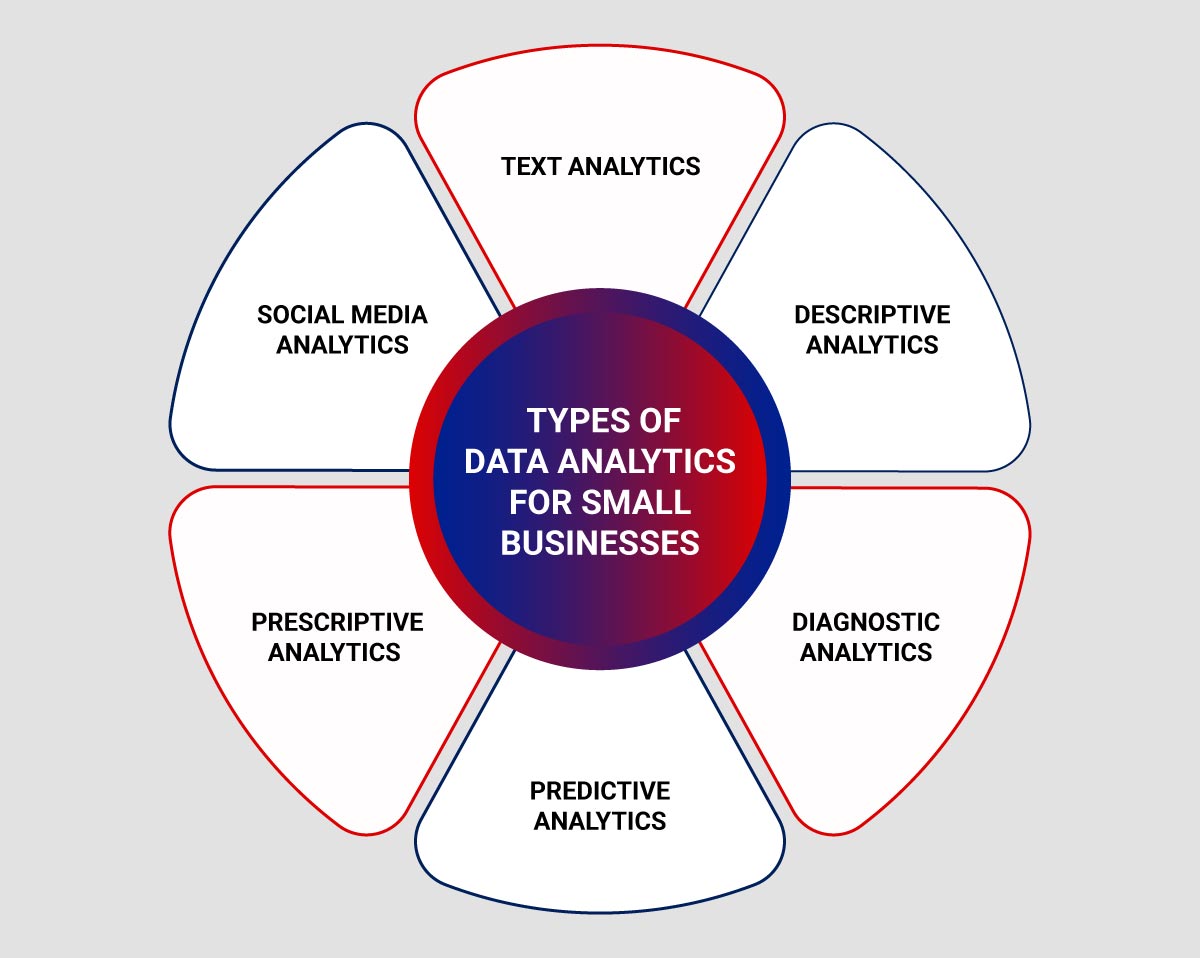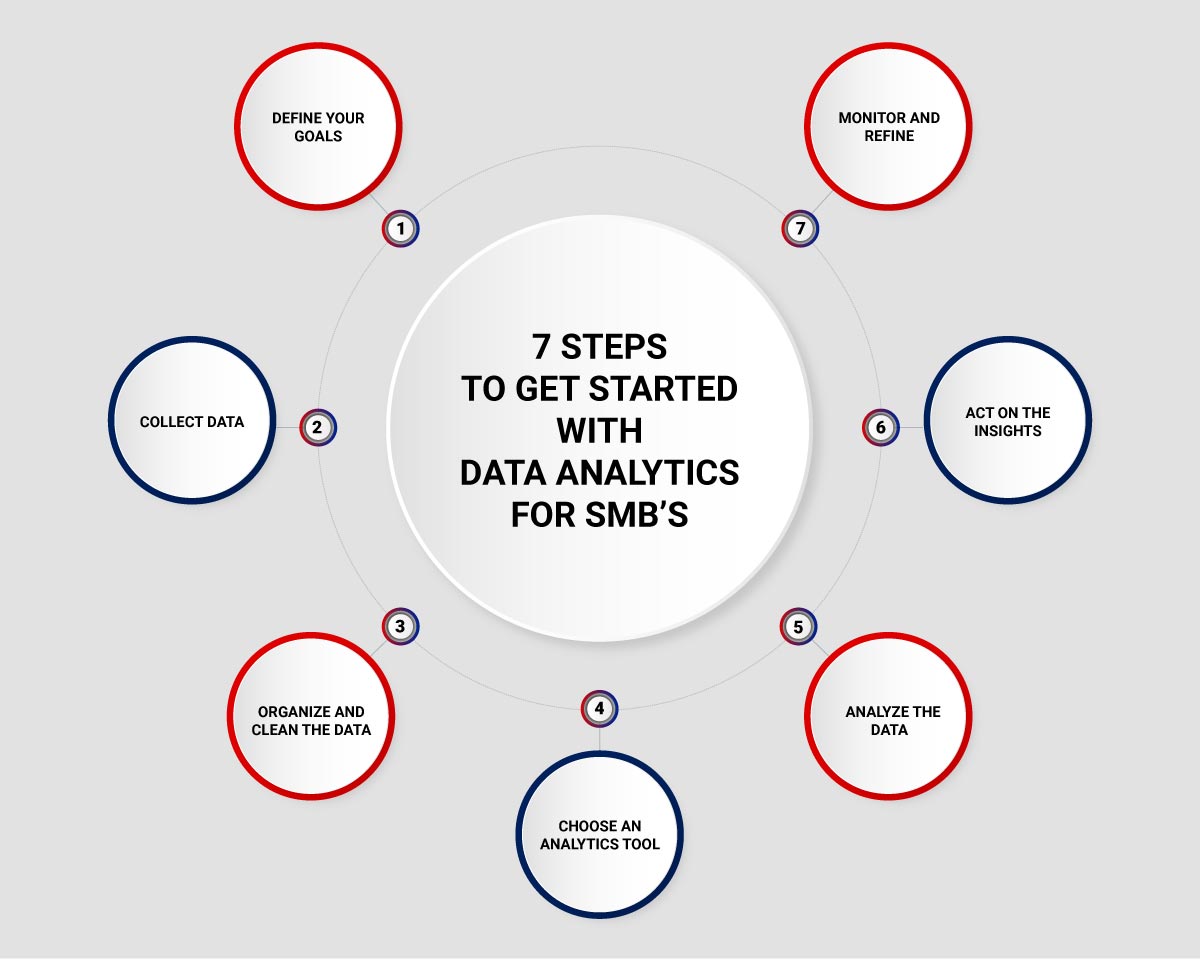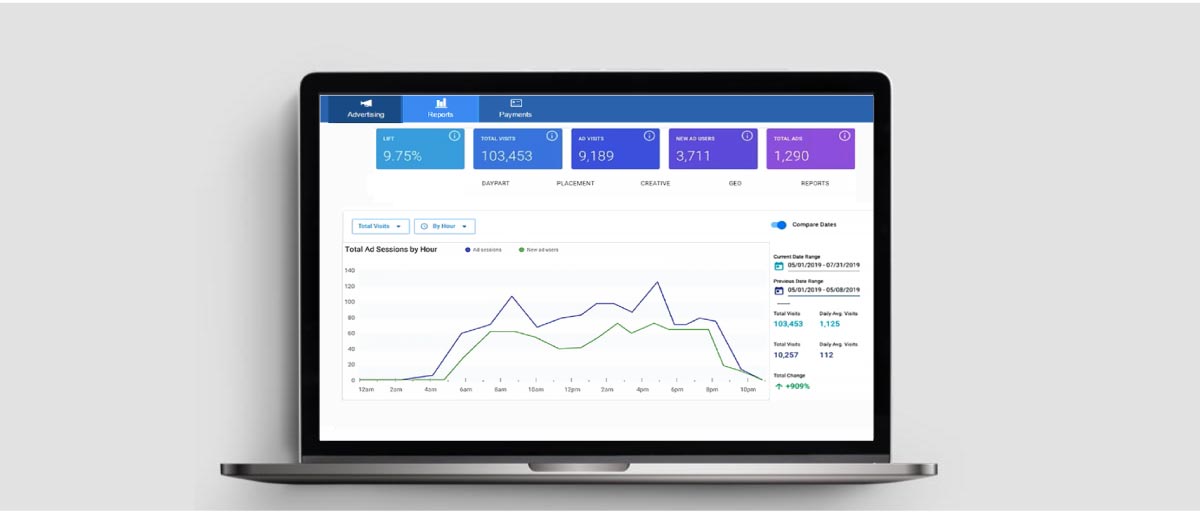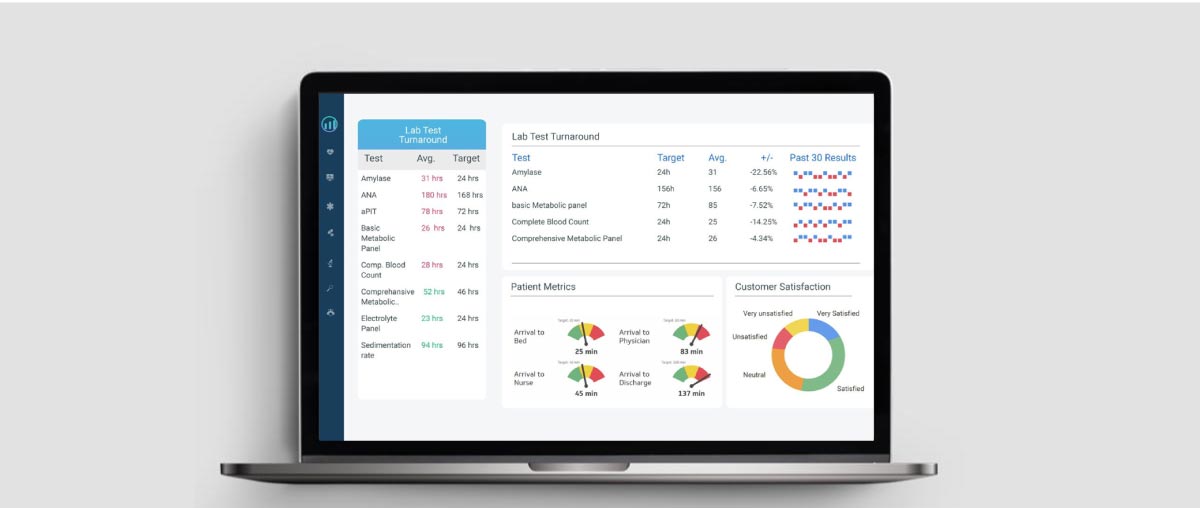Small & medium businesses (SMEs) are considered the backbones of the economy worldwide, creating approximately 70% of jobs & GDP globally. [1] And 33.2 million small businesses in America account for 99.9% of all US businesses. [2] Even though they play a critical role in the economy, SMEs cannot grow quickly due to a lack of strategic planning. With affordable software and cloud-based solutions, small businesses can now easily collect, analyze, and visualize data to gain valuable insights into their operations and make data-driven decisions. While many large corporations have invested heavily in data analytics, small businesses can also benefit from leveraging data to improve processes, identify opportunities, and optimize resources. It enables making informed decisions & gain a competitive advantage.
Through this blog, we will explore the benefits of data analytics for small businesses and provide some tips on how to get started. So, whether you’re a business owner or a decision-maker with an SMB, this blog will provide valuable insights into the power of data analytics and its potential to transform your business.
What is Small Business Data Analytics?
Small business data analytics refers to analyzing and interpreting data generated by small businesses to identify patterns, trends, and insights. It uses specialized software and tools to extract valuable information from large data sets, including customer behavior data, market trends, and internal business operations. By leveraging data analytics, small businesses can identify patterns and trends that might otherwise go unnoticed, allowing them to make data-driven decisions that can help them stay competitive and grow. Analytics for small and medium businesses help extract valuable insights into many aspects of a company, including sales performance, customer behavior, marketing effectiveness, and operational efficiency.
Examples of data analytics applications for SMEs include analyzing customer data to identify buying patterns and preferences, optimizing marketing campaigns to reach target audiences more effectively, forecasting sales and revenue, and identifying cost-saving opportunities.
Current State of Small Business Analytics:
A joint research study [3] conducted by Strategic Finance Magazine & IMA® (Institute of Management Accountants) Research analyzed which data analysis tasks are being performed, the approaches for developing data analysis expertise & the skills sought and more. Here are the key findings;
- Many SMEs use Microsoft Excel as a primary and often the only tool for everyday analytics tasks like data formatting (79%), data cleansing (55%), trend analysis (72%), and visualization (76%).
- 55% of SMEs don’t collect website, social media, or search engine data.
- Almost half, i.e., 48% of SMEs, don’t mine data for patterns, correlations, or anomalies.
- 31% or about one-third of research respondents revealed they don’t combine nonfinancial and financial data, and 21% or nearly one-fifth of respondents said they don’t perform a primary task like financial statement industry comparisons.
How Can Data Analytics Help Small & Medium Businesses
Data Analytics combines big data technologies and advanced statistics, algorithms, and business intelligence tools to extract insights from vast amounts of data and provide objective analysis to inform critical business decisions. Furthermore, automated business solutions can replace numerous manual data analysis procedures. Here are a few ways in which SMBs can utilize data analytics to streamline business performance;
- Fusing a Data-centric Approach to Business: When companies can scrutinize vast quantities of information concerning their business and the market, they can construct a comprehensive depiction of the customer journey. For instance, they can determine how individuals become aware of the brand and what products or services they purchase. Though, the rationale behind their choices, the way they shop, the timing and devices used for shopping, why they abandon their carts, and what inspires them to select a particular brand repeatedly.
Collect Data> Clean Data> Identify Patterns> Make Predictions
By leveraging this information, small businesses can transform how they interact with potential customers, focus on preferred communication channels, and resolve issues expeditiously. Data analytics furnishes insights that present a comprehensive business overview, rendering the need to make decisions solely based on conjecture or emulation of others obsolete. This approach permits companies to operate in a data-driven manner, catering to their business and customer requirements. The crucial point to note is that such a data-centric approach pertains not only to customers but also to a business’s overall performance. Data accumulation and analysis is the key to operating in a data-driven way, streamlining operations, improving HR activities, and more.
- Enhance Inventory Management: Inventory management may not appear critical for small businesses, but lacking a strategy, unclear inventory records, over/under ordering, and other mistakes can detrimentally affect your business. However, with data analytics, you can resolve all these issues. Data analytics can enhance operational efficiency, preventing stockouts, establishing appropriate stock levels, empowering order fulfillment, providing precise product descriptions, and reducing errors and excessive warehouse deliveries. This way, you can collect and analyze data to optimize your existing processes and establish an efficient inventory management system. Additionally, data can be used for predictive purposes. For example, you can maximize stock based on weather forecasts, current trends, and recent consumer queries. By only stocking up on the most popular items and avoiding stock overload, you can efficiently manage inventory and reduce costs. You can significantly improve inventory management and cost savings by monitoring market trends and forecasting future changes.
- Understanding the Market and Competitors: By delving into your business data, you can unearth valuable insights about your competitors and their niche. A business process analyst can help determine the type of clients your competitors target, their purchasing patterns, and their profitability. This information can prove invaluable for small businesses. Small businesses can attract more consumers by promptly adapting to the market’s needs, reducing costs, and offering suitable products and services. Understanding market trends and competitor strategies can help small businesses outmaneuver their competitors and ascend to the top of their industry.
Data analytics can enable SMBs in numerous ways by curtailing operational costs, enhancing their business model, boosting revenue, and outshining the competition. Here are some of the many benefits that Analytics can bring to an SME.
Benefits of Adopting Data Analytics for Small Businesses
Here are some of the benefits of data analytics for SMEs:
- Recognize Your Best Customer Segment: Data analytics help small businesses identify and focus on their most profitable customer segments. You can tailor your marketing efforts to reach these segments more effectively by analyzing customer demographics, behavior, and preferences. It can increase sales, customer loyalty, and overall business success.
- Enhanced Efficiency In Business Processes: Data analytics helps identify inefficiencies in business processes and aids in streamlining them. For example, it can help improve inventory management by avoiding stockout and eliminating excess warehouse deliveries.
- Get A Competitive Edge: Data analytics tools help SMEs collect market and competitor data and analyze customer preferences and dislikes. They can adjust their offerings according to consumer demands and gain a competitive edge. Data analytics also enables the identification of trends from customer data and their digital activities.
- Boost Your ROI (Return On Investment): Data analytics enables small businesses to identify the most effective marketing channels for their target audience. You can analyze customer behavior and channel performance data while focusing your marketing efforts on the channels that deliver the best ROI. It helps in saving time and resources while increasing your chances of success.
- Enhance Customer Experiences & Retention: By analyzing customer data, you can gain insights into what drives customer satisfaction, retention, and loyalty. It helps make data-driven decisions to improve the customer experience, increasing customer loyalty and repeat business.
- Mitigate Customer Churn Risk: By analyzing customer data, you can identify customers at risk of churning and act to prevent it. You could offer targeted promotions or improve their experiences to retain them and boost your customer’s lifetime value.
- Data-Centric Approach: Data analytics helps an organization build a data-backed decision-making culture. It benefits the C-suite and everyone at different stages of the organization because it eliminates human bias and error. It also helps accurately forecast and budget financial metrics like sales, cash flow & more.
Types of Data Analytics Techniques Used by Small Businesses

There are many types of big data analytics for small businesses, and you can utilize these techniques depending on your specific business model. They include:
- Text Analytics: Also called data mining, this technique helps analyze unstructured data such as customer reviews, feedback, and comments. It involves analyzing text data to identify themes, sentiments, and opinions that can help businesses make informed decisions.
- Descriptive Analytics: It involves analyzing historical data to identify patterns, trends, and insights that can help businesses make informed decisions.
- Diagnostic Analytics: This technique identifies past events’ causes, like why sales figures decreased in a certain period. It helps small businesses to identify the root causes of issues and make changes to prevent them from happening again.
- Predictive Analytics: It uses statistical algorithms and machine learning to analyze historical data and predict future events, such as future sales figures or customer behavior. It helps small businesses to anticipate future trends and make informed decisions accordingly.
- Prescriptive Analytics: This data analytics technique utilizes historical and real-time data to recommend actions to optimize business performance. It helps small businesses to make decisions that will have the most significant positive impact on their business.
- Social Media Analytics: This type of analytics is used to understand customer sentiment and behavior on social media platforms. It involves analyzing social media data to identify trends, customer preferences, and opinions about a brand or product.
Top Data Analytics Use Cases in SMBs Across Industries
Small and medium businesses are increasingly adopting data analytics across various functions and industries to derive valuable insights, optimize processes, and drive growth. Here are some of the top data analytics use cases across different business functions:
- Sales and Marketing: Use customer data to identify trends, create targeted marketing campaigns, and optimize sales strategies based on customer preferences and behavior.
- Operations: Optimizing supply chain management, improving inventory management, and reducing operational costs.
- Human Resources: To analyze employee performance, identify skill gaps, and create effective training programs.
- Finance: Discovering cost-saving opportunities, managing risk, and forecasting financial performance.
- Customer Service: To analyze customer feedback, identify areas for improvement, and improve customer satisfaction.
- Product Development: To map customer feedback, identify trends, and create new products that meet customer needs.
- IT and Cybersecurity: Helps detect and prevent cybersecurity threats, identify vulnerabilities, and improve IT performance.
- Research and Development: To analyze market trends, identify emerging technologies, and inform research and development efforts.
Best Data Analytics Tools for Small Businesses
Several data analytics tools are well-suited for small businesses. And through this section, let’s try to explore how could data analytics tools help small businesses:
- Power BI: A cloud-based data analytics tool that enables small businesses to analyze and visualize data from multiple sources. It has a user-friendly interface & can help companies to create interactive dashboards and reports. Read this blog to understand how to utilize Power BI features for extracting useful & actionable insights from data.
- Tableau Public: Tableau Public is a free data visualization tool that enables small businesses to create interactive dashboards and visualizations. It is easy to use and can help companies to identify trends and patterns in their data.
- Google Analytics: This tool enables small businesses to track website traffic, user behavior, and conversion rates. It provides detailed reports on website performance and helps them to optimize their online presence.
- QlikView: A data analytics tool that enables small businesses to analyze large amounts of data quickly and easily. It has built-in features such as data modeling, visualization, and reporting that can help companies to gain insights into their data.
- R: It is a free, open-source programming language widely used for statistical analysis and data visualization. It can help small businesses perform complex data analysis and gain insights into their data.
- SAS: A comprehensive data analytics tool, it can help small businesses perform advanced data analysis and modeling. It has built-in features such as data mining, forecasting, and optimization to gain insights into their data.
In our experience, both Power BI and Tableau are well suited to enable SMBs to meet their specific needs and budget best. Read this blog on Power BI vs. Tableau Comparison to better understand the right data analytics tool for your business.
Data Analytics Challenges Faced by Small & Medium Businesses and How to Overcome Them?
Data analytics can provide SMBs with valuable insights into their operations and customer behavior, but they often lack the resources and expertise to leverage this power of data fully. Let’s explore some of the data analytics challenges faced by SMBs and a few suggestions on how they can overcome them.
- Collecting The Correct Data: With data available everywhere, employees often quickly collect and analyze available data. And the data that can add value gets ignored due to difficulty procuring it. You could train your employees to become data literate and identify the data that can add value to the business.
- Selecting A Suitable Tool: Choosing the best tool for your business is critical, with many options available. Not every tool has the features to meet your company’s needs and expectations. So, it is advisable to take professional help. Get a technical consultation from an experienced and reliable software development company to understand options relevant to your business.
- Limited Resources: SMEs may not have the same resources as larger companies, making investing in data analytics tools and hiring specialized personnel challenging. One strategy to overcome this is to start with free or low-cost analytics tools and gradually invest in more advanced tools as the business grows.
- Consolidating Data From Disparate Sources: The multiple data sources, like your website, social media platform, CRM, emails and more, are often disjointed and scattered. Their data formats and quality vary. So, when done manually, combining and analyzing such data is a challenge. The result could be erroneous and unreliable. It would help to create a centralized data hub that provides easy data access to your employees while reducing their efforts on data collection and improving their analytics efficiency.
- Lack Of Clear Business Goals: SMEs may struggle with defining clear business goals for their data analytics initiatives. One strategy to overcome this is identifying specific business challenges and goals that data analytics can help address, such as improving customer retention or increasing sales.
- Data Quality: Manual data consolidation efforts are prone to errors, and erroneous or flawed data is unreliable. When the quality of input data is poor, you can’t expect to get valuable insights. It could help to automate the data collection process and use forms with drop-down fields and data validation to eliminate human errors. Integrating your systems to exchange data helps update the data in all of them when you make changes in one system. It helps in resolving the issue of asymmetric data within the company. Centralizing the system is another way of improving your data quality.
- Company Culture Of Lack Of Support: While the management may understand the importance of data analytics, they usually make little or no effort to drive the same to all the stages within the company. Middle-level employees suffer from constant pressure and no support in utilizing data analytics to improve their productivity and efficiency. It could help to educate your employees and empower them with the right data analytics tools.
- Data Security: While SMBs start understanding the importance of data, they often overlook the need to secure it. Unprotected data sources are vulnerable to cyber-attacks. The solution is to have apt security and controls in place by utilizing professional help.
- Data Visualization: It is a challenge for most SMBs that can be resolved using the right visualization tools like Power BI and Tableau. They come with intuitive graphs, charts, and other visualization options.
How to Get Started with Data Analytics for Small Businesses?

For small & medium businesses, getting started with data analytics first might seem daunting, but it’s an essential step toward improving decision-making and overall business performance. Here are a few steps you need to consider:
- Define Your Goals: Define what you hope to achieve with data analytics. Identify the key performance indicators (KPIs) critical to your business and how data analytics can help you measure and improve them.
- Collect Data: Collect data from your business operations, customer interactions, and other relevant sources. Include sales, marketing, social media, customer surveys, and more data.
- Organize & Clean Data: Organize and clean the data to ensure it is accurate, consistent, and complete. So it is easier to analyze and derive insights.
- Choose An Analytics Tool: Select an analytics tool well-suited to your business needs and budget. Many options are available, from free tools like Google Analytics to more sophisticated paid tools like Tableau or Power BI.
- Analyze The Data: Use your chosen analytics tool to analyze the data and derive insights. Look for trends, patterns, and relationships between different data points.
- Act-On The Insights: Use your gained insights to make informed decisions and improve your business performance. It might involve changing your marketing strategy, product offerings, or customer service.
- Monitor And Refine: Continuously monitor your KPIs and refine your analytics strategy to ensure you get the most out of your data.
Therefore, a combination of planning, data collection, analysis, and action can help your SMBs get started with data analytics.
Best Practices in Data Analytics for Small Businesses
Explore the best practices in data analytics for small and medium businesses to get actionable business insights. They include:
- Define Clear Business Goals: Identify specific business challenges and goals that data analytics can help address, such as improving customer retention or increasing sales.
- Collect And Maintain High-Quality Data: Ensure data is regularly cleaned and updated and implement data quality controls to address any issues.
- Use Appropriate Data Analytics Tools: Choose the tools and techniques that fit your business needs, budget, and resources.
- Invest In Employee Training: Invest in employee training to ensure your team has the necessary data literacy skills to analyze and interpret data effectively.
- Start Small & Scale Gradually: Start with small projects and gradually scale up as you gain more experience and resources.
- Collaborate Across Departments: Collaborate across departments to ensure that data analytics is integrated into all aspects of your business operations.
- Implement Data Security Protocols: Implement robust data security protocols to protect sensitive data from breaches and cyber attacks.
- Continuously Evaluate & Adjust: Evaluate the effectiveness of your data analytics initiatives and adjust your strategies as needed to ensure that they align with your business goals.
- Take Professional Help: If you don’t have the necessary in-house skills, consider hiring a company that offers data analysis for small & medium businesses to ensure you can make the most of your data.
How Can Rishabh Help with Data Analytics for Small Businesses?
As a data analytics services company, we offer various services to medium-sized businesses (SMBs), including Business Intelligence & Data Visualization, Data Engineering & more. Here are some ways how we help SMBs:
- Data Analysis And Visualization: We offer data analysis & create interactive visualizations that enable them to gain insights into their business. It could include data modeling, trend analysis, and more.
- Data Integration: We help integrate data from multiple sources, such as CRM systems, ERP systems, and social media platforms. It allows SMBs to view their data and make informed decisions comprehensively.
- Cloud-Based Data Analytics: We help SMBs migrate their data analytics to the cloud, which can provide scalability, security, and cost savings. It enables them to access their data from anywhere and improves collaboration between team members.
Success Stories:
Case Study 1: Digital Ad Order Management Solution with Data Analytics

An outdoor advertising company managing digital advertising panels wanted to reach a broader range of consumers, maximize inventory allocation and boost sales. We developed an online advertising booking system by leveraging our data analytics capabilities to help them respond to booking requests immediately, leverage sales opportunities, and maximize revenue.
Key takeaways;
- 80% reduction in unsold Inventory items
- <2 minutes booking response time as compared to 30 minutes earlier
- Real-time monitoring of bookings as per segment & point of sale mechanism
Read more about how our Ad order management system with BI and Data Analytics helped the client.
Case Study 2: Machine Learning-Driven Healthcare Monitoring System

A UK-based mid-sized medical service provider was in pursuit of creating a standalone system that offers real-time human activity recognition within the clinical systems to provide better diagnosis & treatment for critical care patients. Our team developed an ML-based healthcare monitoring system. It offers actionable insights to help collate the recorded data, including historical & current health data sets, from various connected devices and the patient’s vitals.
Key takeaways;
- 5x increase in operational efficiency
- 63% accurate diagnosis through ML models
- Real-time data collection & patient-intelligence
Read more about how our ML-based Healthcare Monitoring System helped the client.
Concluding Thoughts
Data analytics is no longer just for big corporations with big budgets. Small and medium companies can also benefit significantly from leveraging the power of data to make informed decisions, boost ROI, and respond to market changes quickly, and that’s where our data analytics consulting services can provide tailored support. Analytics for small and medium businesses can help identify and focus on their best customer segments, increase customer satisfaction and loyalty, predict and prevent churn, identify new business opportunities, and more. The key is to start small, identify specific goals, and build the necessary infrastructure to collect and analyze data. With the right tools and approach, small and medium businesses can gain a competitive advantage and drive long-term success.
Footnotes:
3. https://sfmagazine.com/articles/2022/may/an-sme-approach-to-data-analytics/?psso=true











 30 Min
30 Min


